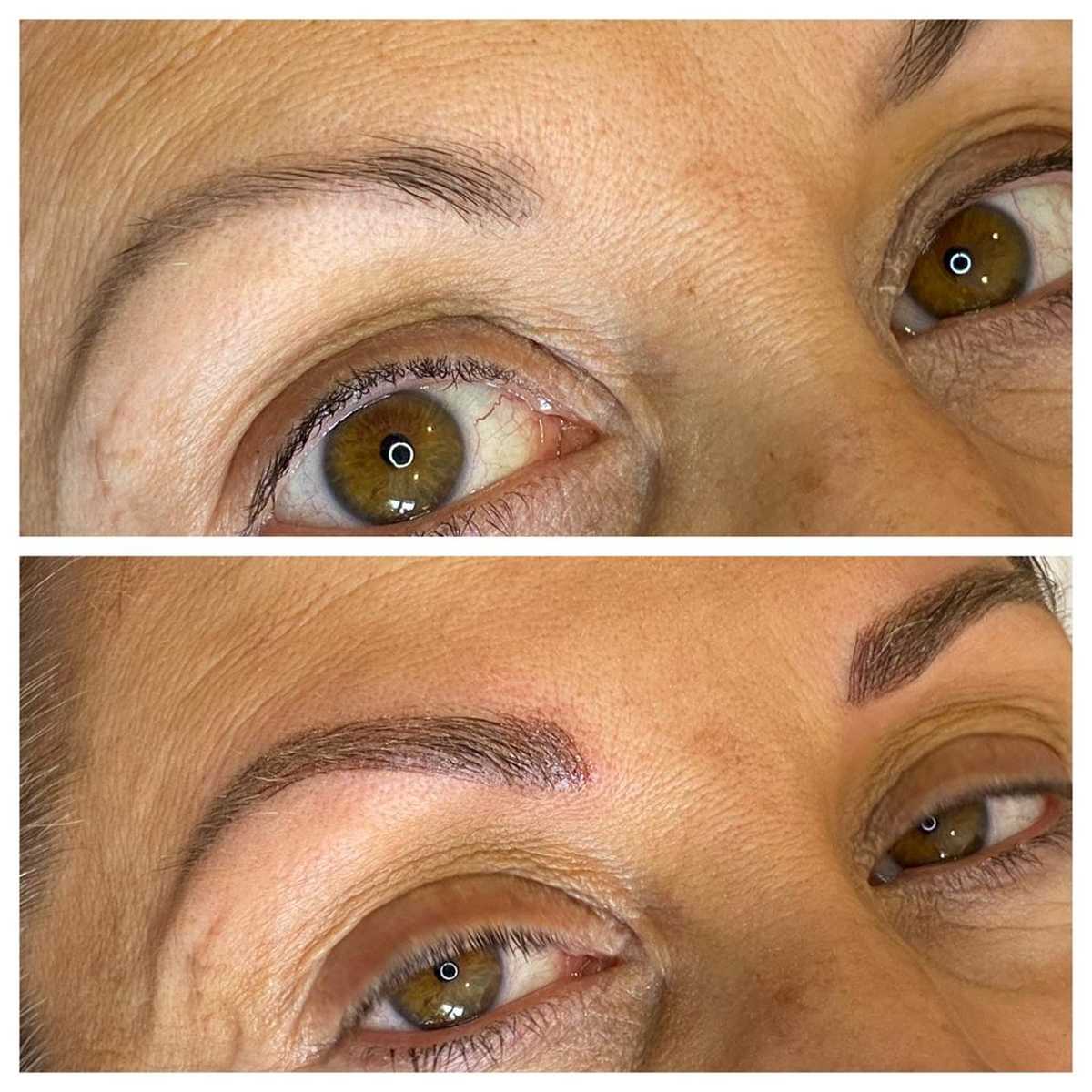Microblading has revolutionised the world of permanent cosmetics, providing a natural and long-lasting solution for enhancing eyebrows. However, to achieve the best results, the post-treatment care is as essential as the procedure itself.
A common question among those who undergo microblading is, “How soon can I wash my face after the procedure?” This article aims to provide clear guidance on caring for your new brows and ensuring they heal perfectly.
Proper aftercare is crucial to the success of your microblading treatment. Without following the recommended regimen, you risk fading, infection, or even the loss of pigment.
One of the most important aspects of aftercare is how and when you wash your face.
Let’s get straight to the point
Proper aftercare is essential for successful microblading results. Most professionals advise avoiding washing your face for 2-10 days post-treatment, with care needed when cleaning around the brows.
On Day 1, blot lymph fluid gently to prevent crusting, and use mild antibacterial soap from Day 2-10 for cleaning. In the shower, keep water away from brows using protective methods like goggles.
Moisturise lightly to prevent pigment loss, and avoid makeup, sweating, and harsh chemicals. Failure to follow these guidelines can cause pigment fading, scabbing, or infection. Healing typically takes 6-8 weeks, with regular maintenance needed for lasting results.
How Soon Can You Wash Your Face After Microblading?
While it’s tempting to splash your face with water, especially if you’re used to regular cleansing, you should avoid washing your brows immediately after microblading. Most professionals recommend waiting 2-10 days before properly washing your face, depending on your skin’s healing process.
Here’s a breakdown of the washing stages:
Washing Your Eyebrows: Day One
For the first few hours after your treatment, you should avoid water entirely. Your skin will produce lymph fluid, which helps in the healing process.
It’s essential to gently blot this fluid from your brows using a cotton pad and sterile water. The fluid can cause crusting if left unchecked, leading to potential pigment loss.
Washing Your Brows: Day 2-10
During this period, washing your face becomes more manageable but still requires caution. Use a light antibacterial soap and lukewarm water to cleanse your face without directly scrubbing your brows.
Instead, use gentle dabbing motions to clean around the brow area. After cleansing, dry the area with a soft tissue.
Keeping Your Brows Dry in the Shower
It’s not just about washing your face—brows need protection while showering. Water can dilute the pigment, so here’s how to shower safely:
- Turn away from the water: Keep your face turned away from the showerhead to avoid splashes.
- Goggles: Consider wearing protective eyewear, such as swimming goggles, to shield your brows.
- Pat, don’t rub: After showering, gently pat your face with a soft tissue. Avoid rubbing the brow area to prevent any accidental removal of pigment or disruption of healing skin.
What Happens If Your Brows Get Wet Too Early?
Accidentally getting your eyebrows wet can cause several issues, including:
- Pigment dilution: Water dilutes the pigment, leading to premature fading.
- Scabbing: Water may cause scabbing, which could flake off, removing the pigment along with it.
- Infection: If water isn’t sterile, it can introduce bacteria into the healing skin, leading to infection.
Moisturising Your Microbladed Brows
Keeping your microbladed brows moisturised is crucial, but over-moisturising can block pores and slow the healing process. Your technician will likely provide or recommend a suitable ointment. Apply it sparingly once or twice daily, and always use clean fingers.
How to Speed Up the Healing Process?
If you’re eager for your brows to heal faster, there are a few tips you can follow to ensure a smooth recovery.
1. Use a Gentle Cleanser
Stick to a mild, antibacterial soap to clean your face. Avoid products containing harsh chemicals like Retin A or glycolic acid, which can interfere with the healing process.
2. Avoid Makeup
During the healing period, resist the urge to apply makeup to the brow area. Makeup can introduce bacteria to the healing skin and interfere with the retention of pigment.
3. Apply Aftercare Ointment
As mentioned earlier, apply the recommended ointment sparingly. Avoid applying too much, as this can trap dirt and bacteria in the area, slowing down the healing process.
4. Limit Exposure to Certain Activities
Certain activities, such as tanning, excessive sweating, or intense workouts, can affect your healing brows. Avoiding these activities will help prevent sweat or dirt from entering the brow area, reducing the risk of infection and pigment loss.
What Happens If You Don’t Follow the Aftercare Guidelines?
Not adhering to the recommended aftercare routine can lead to several complications. For example, not cleaning the lymph fluid on Day 1 can result in crusting, which can lift and remove pigment from the skin.
This can leave you with uneven brows or even require touch-ups sooner than expected.
Healing Timeline and Stages
Every individual heals differently, but here’s a general timeline for what to expect during your recovery process:
- Day 1-3: Brows appear bold and slightly swollen. Lymph fluid may be present.
- Day 4-7: The skin begins to dry and scab lightly.
- Day 8-14: Scabs fall off naturally, revealing a softer, more natural brow appearance.
- Week 6-8: The final result is visible after full healing. A follow-up appointment may be required for any necessary touch-ups.
Long-Term Maintenance for Microbladed Brows
Once your brows have fully healed, maintaining their appearance is still essential. To prolong the life of your microblading:
- Avoid excessive sun exposure: Sunlight can fade the pigment over time, so consider wearing a hat or applying SPF when going outside.
- Limit facial exfoliation: Avoid using exfoliants directly on your brows, as this can wear down the pigment.
- Stay hydrated: Keeping your skin hydrated ensures that the pigment stays bright and healthy-looking.
Conclusion
Microblading can provide a significant enhancement to your natural brows, but proper aftercare is essential for the best results. The key to successful healing is keeping the area dry, using gentle products, and following your technician’s instructions.
Avoid washing your face for the first 2-10 days, and once you can wash it, take precautions to protect your brows. The healing process may seem long, but taking these steps will ensure that your brows look their best for months, or even years, to come.
By following these guidelines, you will not only protect your investment but also enjoy the long-lasting beauty of your new brows.
FAQs About Microblading
Can I Get My Eyebrows Wet Seven Days After Microblading?
For at least a week, you should keep the area dry. This includes not getting water on your face when you shower. Also, at least one week should pass without you applying any makeup.
This is occuring due to the colours continuing to settle into the shallow incisions in your skin that were produced by the blading.
How Do I Know When My Microblading Is Healed?
After one month, your skin will be entirely restored to normal. You shouldn’t be experiencing any pain or discomfort at all. Make sure that your eyebrows are fluffy and thick looking.
You will likely have a follow-up consultation with your provider in another month or two after that.
Why Has My Microblading Disappeared?
When the top layer of skin peels off, the microblading strokes frequently vanish by that point. THIS IS TO BE EXPECTED. This is because there is still a substantial layer of protecting skin acting as a veil over the pigment.
How Can I Make My Microblading Last Longer?
After your microblading appointment, you should avoid going into the sun as much as possible. Sun exposure must be reduced during the healing process.
Using an SPF product on the brows or covering the face with a hat or visor when you are out in the sun will help keep your brows looking fresh. During this time, solar exposure should be minimised.
Why Is My Microblading Not Peeling?
Customers with oily skin types do not experience scabbing after microblading is performed on them. This is because oily skin secretes sufficient sebum to keep the treated area moist and avoid substantial lymph leaking.


